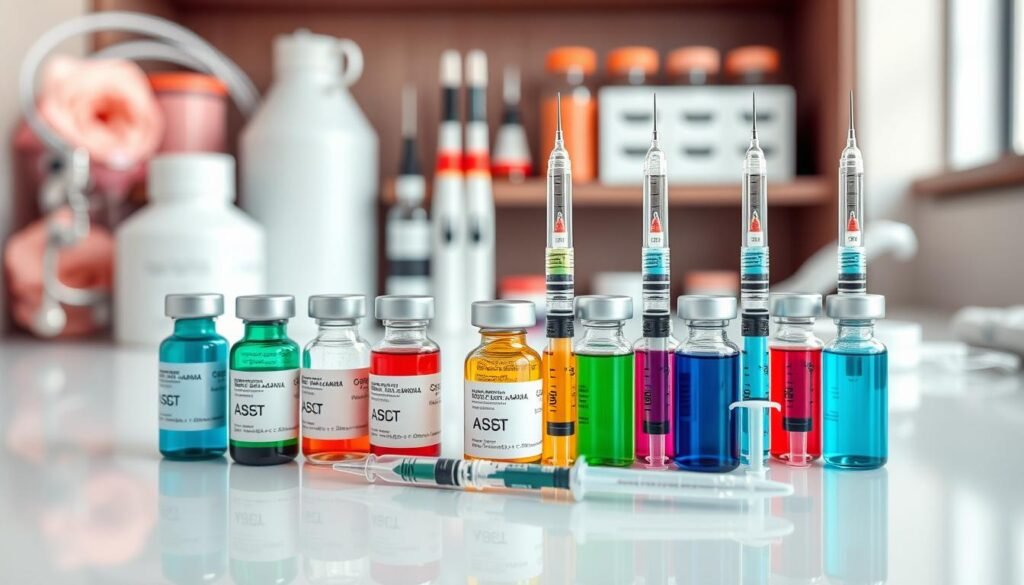Did you know many people have anemia but don’t realize it? Around 3.5 million U.S. individuals live with it. This section highlights medications for treating anemia. It stresses knowing the symptoms and the available anemia treatment drugs.
By learning about anemia medication options, patients can better their lives. It’s crucial for taking control of this widespread issue.
Key Takeaways
- Anemia affects about 3.5 million people in the U.S.
- Recognizing symptoms is crucial for early diagnosis.
- There are various treatment drugs available for anemia.
- Understanding treatment options can improve patient outcomes.
- Consulting a healthcare provider is essential for tailored treatment.
For more details on symptoms and how to treat them, visit the Mayo Clinic.
Understanding Anemia: Causes and Symptoms
Anemia affects many people and can come from different factors. These include not getting enough vitamins and chronic conditions. Not having enough iron, folate, and vitamin B12 is a big problem. These nutrients help make red blood cells. Without them, our bodies can’t send enough oxygen everywhere needed.
Illnesses like kidney disease might also cause anemia. They make it hard for the body to make enough red blood cells. Also, genetic problems like sickle cell anemia change red blood cells. This makes them die faster and lowers their number.
People with anemia often feel very tired and weak. They might look pale and have trouble breathing. These are signs of anemia.
It’s important to know these signs to catch anemia early. If you know what to look for, you can get help sooner. Early action helps make treatment better. This improves health and life quality.
Types of Anemia and Their Treatment Approaches
It’s key to know the different types of anemia for effective care. Iron-deficiency, pernicious, aplastic, and hemolytic anemia are the main types. Each one needs its own special anemia treatment approaches.
Iron-deficiency anemia comes from not having enough iron or losing too much blood. The fix often involves eating more iron-rich foods like red meat, beans, and leafy greens. Sometimes, iron pills are needed to quickly up iron levels.
Pernicious anemia happens because of a vitamin B12 shortage. This vitamin is vital for making red blood cells. Getting vitamin B12 shots or taking high-dose pills usually solves the problem.
Aplastic anemia is when your body can’t make enough blood cells. This serious issue might need blood transfusions, medicine to suppress the immune system, or stem cell transplants in tough cases.
Hemolytic anemia means red blood cells are destroyed too soon. Fixing the root cause, which might be autoimmune diseases or infections, is key. Some might need meds that calm the immune system.
Finding out exactly which anemia you have is crucial for the right treatment. For detailed info on types of anemia and ways to treat them, checking out resources helps a lot.

| Type of Anemia | Causes | Treatment Approaches |
|---|---|---|
| Iron-deficiency Anemia | Inadequate iron intake, blood loss | Dietary changes, iron supplements |
| Pernicious Anemia | Lack of B12 absorption | B12 injections, high-dose supplements |
| Aplastic Anemia | Bone marrow failure | Blood transfusions, stem cell therapy |
| Hemolytic Anemia | Premature red blood cell destruction | Treat underlying causes, medications |
Medications for Treating Anemia: An Overview
It’s crucial to know about the various anemia treatments. This overview explains how these treatments work to bring back healthy blood levels. They also help ease the symptoms linked to anemia.
Some of the top medications prescribed are:
- Iron Supplements: Vital for boosting iron stores for hemoglobin creation.
- Vitamin B12 Injections: Great for those who struggle with B12 absorption, improving red blood cell count.
- Erythropoietin Hormone Therapies: This hormone aids in making more red blood cells, helping those with chronic kidney disease.
Sticking with your medication is key to successful treatment. Healthcare providers need to check regularly if the treatment works. They might change the plan if needed. Patients should work closely with their care team to pick the best treatment for them.
Oral Medications for Anemia: Common Options
Oral meds for anemia are key in getting nutrient levels right and boosting health. They often include iron supplements, folic acid, and vitamin B12. Knowing how these help can guide people in choosing how to manage anemia.
Iron Supplements: How They Work
Iron supplements are mainly used to fight iron deficiency anemia. They boost hemoglobin, which carries oxygen in the body. Once taken, iron gets absorbed in the intestines. It then moves into the bloodstream and goes to the bone marrow. There, it helps make red blood cells.
There are various iron supplement types, like ferrous sulfate and ferrous gluconate. These forms can raise iron levels. However, it’s important to know that some foods and meds might block iron absorption. Elements such as calcium and caffeine could interfere if taken at the same time. For more details on these options, visit this source.
Folic Acid and Vitamin B12: Their Role in Treatment
Folic acid and vitamin B12 are vital for making red blood cells and DNA. Folic acid helps grow new cells. Vitamin B12 aids in red blood cell maturity and prevents megaloblastic anemia. Not getting enough of these nutrients can cause fatigue and weakness.
It’s smart to include these nutrients in your diet or through supplements, especially if you’re at risk. Leafy greens and beans have folic acid. Vitamin B12 is in fish, meat, and dairy. Some might need to take extra supplements. A balanced anemia treatment plan includes iron, folic acid, and vitamin B12.

Injectable Anemia Treatments: What to Know
Injectable anemia treatments are important for those with chronic kidney disease or cancer patients. One key type is Erythropoiesis-Stimulating Agents. They help the bone marrow make more red blood cells, crucial for anemia management.

Erythropoiesis-Stimulating Agents (ESAs)
Erythropoiesis-Stimulating Agents target anemia’s unique needs. Given by injection, they boost hemoglobin levels effectively. Knowing the right dose and how to give it is key to their success and safety.
Doctors must watch how patients react to these medications closely. Continuous checks keep the treatment on track. Patients must follow doctor’s instructions on how to use and store these injections. For more info on epoetin alfa injections, healthcare workers look at this page.
Staying in touch with healthcare providers is vital during treatment. To manage anemia well with injectable therapies, understand their pros and proper care.
Best Drugs for Anemia: A Closer Look
Finding the right drugs for anemia is key to managing it well. Ferrous sulfate is a top choice for many. It’s a trusted iron supplement that boosts hemoglobin levels. This makes it a go-to for those with iron deficiency anemia.
Epoetin alfa plays a big role for those on dialysis or with certain diseases. It helps make more red blood cells. This helps people deal with their anemia better.
New drugs called HIF-PH inhibitors are changing the anemia treatment game. They trick the body into making more red blood cells in a new way. Studies show they might work well, especially for those who haven’t had luck with other treatments.
Here’s a comparison of some key anemia prescription drugs:
| Drug | Usage | Efficacy | Potential Risks |
|---|---|---|---|
| Ferrous sulfate | Iron deficiency anemia | High | Gastrointestinal upset |
| Epoetin alfa | Chronic kidney disease, chemotherapy | Moderate to high | Hypertension, increased risk of thrombosis |
| HIF-PH inhibitors | Chronic anemia conditions | Promising | Common cold symptoms, headaches |
Choosing the best anemia drugs means looking at your own health needs and the drug’s side effects. Knowing your options helps manage anemia better. This improves health and quality of life.
Anemia Drug List: Essential Medications
A comprehensive anemia drug list helps patients, caregivers, and healthcare providers make informed decisions about treatment. It covers various medication types like oral and injectable, and even alternative treatments. Each entry includes uses, how the drug works, and possible side effects. Knowing this information simplifies handling anemia treatment.
| Medication | Type | Indications | Mechanism of Action | Potential Side Effects |
|---|---|---|---|---|
| Ferrous Sulfate | Oral | Iron deficiency anemia | Increases iron levels | Nausea, constipation |
| Folic Acid | Oral | Megaloblastic anemia | Helps produce red blood cells | Allergic reactions |
| Cyanocobalamin (Vitamin B12) | Oral/Injectable | Vitamin B12 deficiency anemia | Aids in hemoglobin formation | Headache, dizziness |
| Epoetin Alpha | Injectable | Anemia due to chronic kidney disease | Stimulates red blood cell production | Hypertension, fever |
| Darbepoetin Alpha | Injectable | Anemia in cancer patients | Enhances erythropoiesis | Fatigue, nausea |
| Iron Sucrose | Injectable | Iron deficiency anemia | Supplements iron levels | Hypotension, headache |
| Hyaluronic Acid | Alternative | Superficial wounds | Promotes healing | Skin irritation |
Using the anemia drug list helps people understand the best medication options for anemia. It allows patients to talk more effectively with their healthcare providers about treatment choices. This leads to better care strategies and outcomes for those dealing with anemia.
Managing Side Effects of Anemia Medications
Treating anemia involves being aware of medication side effects. Iron supplements, a common treatment, can cause stomach upset, allergic reactions, or skin issues from shots. It’s crucial to talk openly with doctors to manage any side effects well.
Common Side Effects
Iron pills often lead to stomach problems like nausea or constipation. Shots for anemia can also cause allergic reactions and skin irritation. Spotting these issues early helps deal with them quickly and reduces worry about treatment.
Tips for Mitigating Side Effects
To make treatment easier, there are steps to lessen side effects. Taking pills with meals, drinking plenty of water, and chatting with doctors can help. For more on anemia and managing its side effects, visit this detailed guide on anemia. Following these tips not only feels better but helps keep up with treatment.